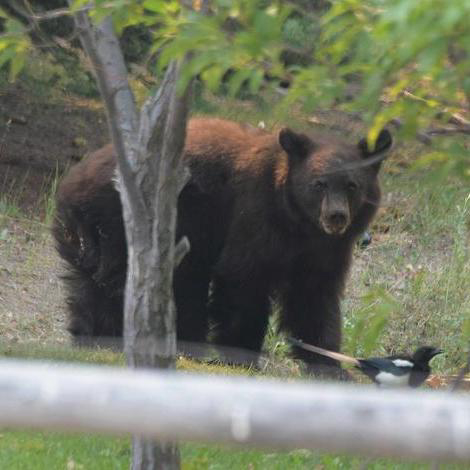
|
Black bears are once again making appearances in neighborhoods across the Wood River Valley
With summer vegetation and berries peaking, bears are actively foraging and working to pack on fat before the long winter ahead. Unfortunately, some are finding their way into residential areas in search of easy meals.
Bears have an incredible sense of smell—and that’s the problem
It’s estimated that a bear’s sense of smell is seven times stronger than a bloodhound’s and can detect scents from miles away. That incredible ability helps them survive—but it also draws them into places they don’t belong, especially when human food sources are easily accessible.
From fermenting garbage to bird seed and hummingbird feeders, bears are attracted to common household items. And once they’ve been rewarded with food, they’ll keep coming back.
When bears find food around homes, everyone loses
Living in Idaho means sharing the landscape with wildlife—something residents take great pride in. But with that privilege comes responsibility.
When bears get comfortable around homes, they begin to lose their natural fear of people. What may start as a curious visit can quickly become a dangerous pattern. A bear that learns to associate people and homes with food often ends up euthanized for public safety.
Letting a bear become a regular visitor—even by doing nothing—sends the message that it’s welcome. And that can have serious consequences.
What you can do right now
Don’t wait for a problem to show up in your yard. Take proactive steps to prevent conflicts before they start:
If you see a bear—act immediately (and safely)
If a bear is around your home or in your neighborhood, action should be taken immediately—if it can be done safely. Hazing the bear by yelling, clapping, banging pots and pans, or using airhorns can send the message that it is not welcome and preserve the wild nature of bears that is essential for their survival. Bears are intelligent and can quickly learn which areas to avoid.
Why relocation isn’t the answer
Bears that have become food-conditioned cannot simply be moved. Often, they’ll return to the same spot—or bring the problem to a new area. For public safety, Idaho Fish and Game may be forced to euthanize bears that repeatedly seek out human food sources.
“We all have a role to play,” says Senior Conservation Officer Brandyn Hurd. “Keeping bears wild and people safe starts at home. By removing attractants and taking a few simple precautions, we can reduce bear conflicts and help keep these animals where they belong—in the wild.”
For more information about bears, contact the Magic Valley Regional Office at (208) 324-4359.